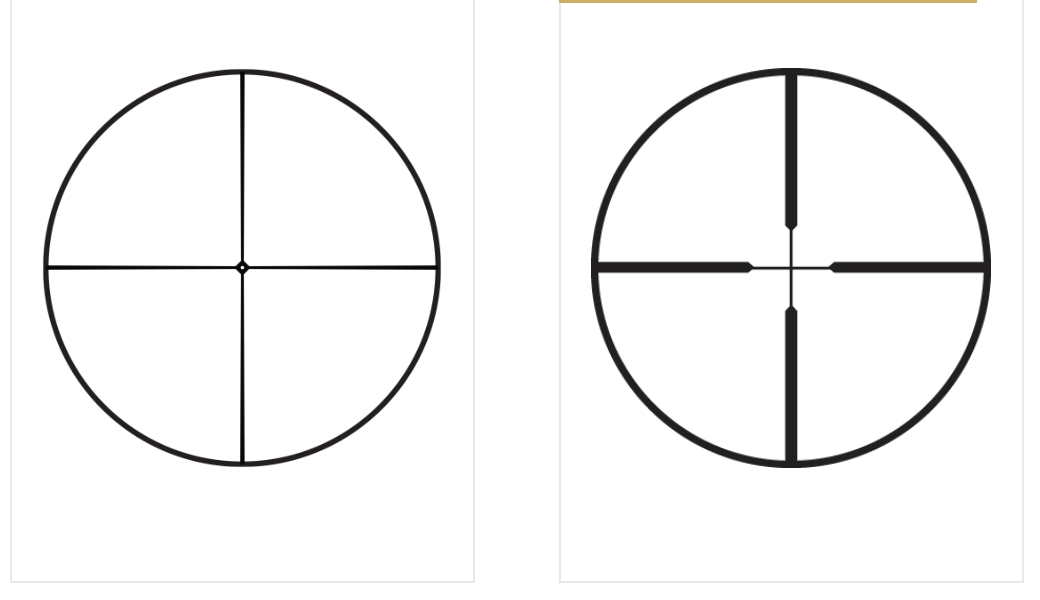In Praise of the Duplex Reticle
A little background
The first documented telescopic rifle sight was invented between 1835 and 1840. Since then, there have been numerous advances and improvements in the devices we commonly referred to as “rifle scopes.” The first telescopic sights were made with a single magnification level, usually included a simple crosshair, and were often in excess of 3 feet long.
Today, the most common rifle scope sold is still the variable magnification scope in 3X to 9X and includes either a simple fine crosshair or duplex reticle.

A Standard crosshair with “diamond” reticle vs. a Duplex Reticle
Noted firearms writer, Richard Mann, recently penned an article with some well-researched statistics regarding rifle scopes. (Find it here)
Despite all the advances in rifles, bullets, and optics, over the past 150 years or so, The average shot a hunter takes at big game is still under 200 yards.
There are many folks out there who would have no issues taking that shot with traditional fixed metal sights.
The average magnification used for these shots was between 5 and 6X.
What this means is that for your typical hunter or outdoorsman, the vast majority of rifle scopes on the market today are both over-magnified and over-complicated based on their needs.
Maximum Point Blank Range
Maximum point blank range is the maximum distance you can hit a game-sized vital area with the same aiming point. The typical, big game rifle sided in at 3 inches high at 100 yards has a maximum point blank range of between 300 and 350 yards, depending on ballistics and trajectory.
What this means is that anything beyond a simple crosshair would be considered superfluous up to that range. It is also well beyond the 200 yards that is the average shot taken at big game across all species and across all continents.

Use of more complicated reticles requires some study and a great deal of practice to use them to their potential.
The Advantages of a Duplex Reticle
Weight
In most circumstances, the simpler the rifle scope is, the less it weighs. That means that a 3X to 9X rifle scope with fine or duplex crosshairs, a 1-inch diameter tube, and a 40 mm objective will weigh less (and, often, SUBSTANTIALLY less) than a rifle with a 34 mm tube, adjustable turrets, parallax adjustment knobs, and a 50 to 55 mm objective lens.
Cost
The lack of additional machining, parts, and the sheer amount of materials necessary to manufacture each of these scopes also means that all else being equal, a scope with a simple crosshair and 1-inch tube will cost less, and, sometimes, substantially less, than one with a larger tube, objective lens, detailed and/or complicated reticle, and multiple adjustment knobs.
Complexity
There is a lot less knowledge of things like wind drift, bullet drop, precise distance, and adjustments with a simpler scope shooting at the majority of big-game shot distances.
Ponder these two similar scenarios…
You are glassing from a high vantage point in the mountain west when, suddenly, the buck of a lifetime steps out into an opening in the brush. He is following some does throughout the cover and you know you may only have a second or two to take your shot. You quickly reach for your rangefinder and discover the distance is 229 yards. You glance at your ballistics table taped to the rifle of your stock and determine you need to turn your top adjustment knob four clicks to the left, adjust your parallax from 100 to 200 yards, then set your rifle on a stable rest such as a set of shooting sticks or, at minimum, your pack, in order to have a steady aim and fire. As your eye comes into alignment with the scope, you see the deer‘s hind legs disappearing in the brush to the right, never to be seen again.
Now imagine the same situation with a simple rifle scope that has a duplex-type reticle in it.
You glass that same buck in the same scenario and estimate the distance to be “about 200 yards.“ You throw your rifle onto the shooting sticks. The duplex reticle inside the scope draws your vision immediately to the fine cross-hair center. You then take careful him, let out half a breath, and fire, because you know that your rifle will make an ethical shot on that animal anywhere from 25 to 300+ yards. The buck leaps straight into the air, signaling to you that you have made a solid hit. Based on the area you were aiming at behind the buck’s front shoulder, you are confident that you hit him in a vital area. You walk to the area the buck was standing, find his tracks, see bright red blood with some bubbles in it look in the direction the buck was traveling and see him lying motionless approximately 30 yards away.
Final Thoughts
By all means, if you want to purchase the latest, greatest, gigantic rifle scope that allows you to precisely shoot out past a half mile and more, by all means, feel free to do so.
I prefer simplicity whenever I am in the field, and find myself most often reaching for my trusty deer rifle with a 3 to 9X scope.